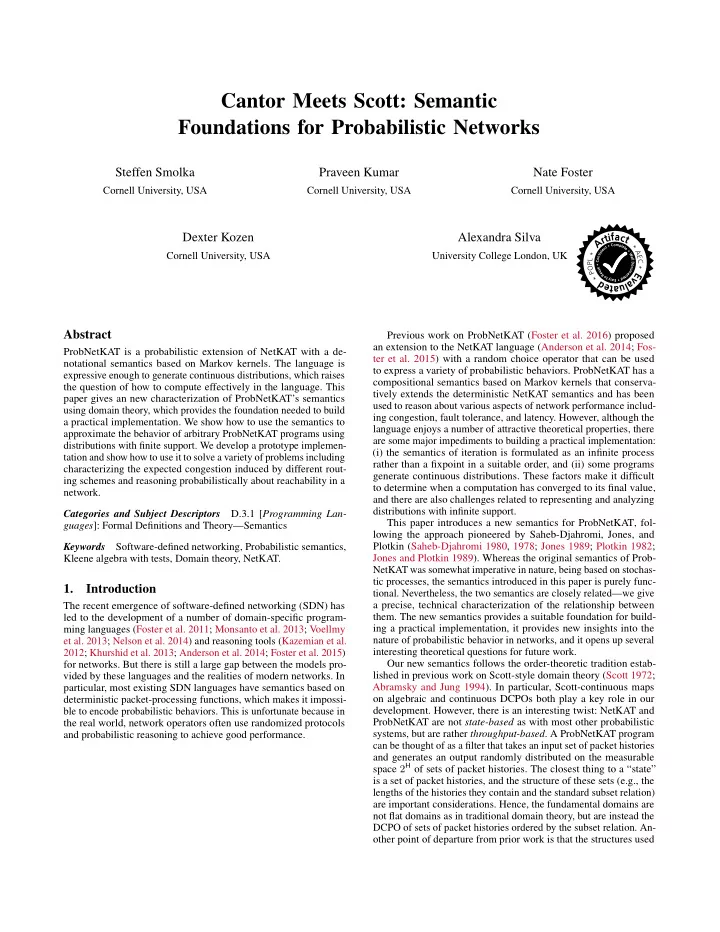

Cantor Meets Scott: Semantic Foundations for Probabilistic Networks Steffen Smolka Praveen Kumar Nate Foster Cornell University, USA Cornell University, USA Cornell University, USA i f a c Dexter Kozen Alexandra Silva t r t A * C o m p * l e t t n e e t * A * s Cornell University, USA University College London, UK s i W E n e L o l C C l P D * o O * e c u s P u m e E e R n * o t t e v y d s a E * d a e l u t a Abstract Previous work on ProbNetKAT (Foster et al. 2016) proposed an extension to the NetKAT language (Anderson et al. 2014; Fos- ProbNetKAT is a probabilistic extension of NetKAT with a de- ter et al. 2015) with a random choice operator that can be used notational semantics based on Markov kernels. The language is to express a variety of probabilistic behaviors. ProbNetKAT has a expressive enough to generate continuous distributions, which raises compositional semantics based on Markov kernels that conserva- the question of how to compute effectively in the language. This tively extends the deterministic NetKAT semantics and has been paper gives an new characterization of ProbNetKAT’s semantics used to reason about various aspects of network performance includ- using domain theory, which provides the foundation needed to build ing congestion, fault tolerance, and latency. However, although the a practical implementation. We show how to use the semantics to language enjoys a number of attractive theoretical properties, there approximate the behavior of arbitrary ProbNetKAT programs using are some major impediments to building a practical implementation: distributions with finite support. We develop a prototype implemen- (i) the semantics of iteration is formulated as an infinite process tation and show how to use it to solve a variety of problems including rather than a fixpoint in a suitable order, and (ii) some programs characterizing the expected congestion induced by different rout- generate continuous distributions. These factors make it difficult ing schemes and reasoning probabilistically about reachability in a to determine when a computation has converged to its final value, network. and there are also challenges related to representing and analyzing distributions with infinite support. Categories and Subject Descriptors D.3.1 [ Programming Lan- This paper introduces a new semantics for ProbNetKAT , fol- guages ]: Formal Definitions and Theory—Semantics lowing the approach pioneered by Saheb-Djahromi, Jones, and Plotkin (Saheb-Djahromi 1980, 1978; Jones 1989; Plotkin 1982; Keywords Software-defined networking, Probabilistic semantics, Jones and Plotkin 1989). Whereas the original semantics of Prob- Kleene algebra with tests, Domain theory, NetKAT. NetKAT was somewhat imperative in nature, being based on stochas- tic processes, the semantics introduced in this paper is purely func- 1. Introduction tional. Nevertheless, the two semantics are closely related—we give a precise, technical characterization of the relationship between The recent emergence of software-defined networking (SDN) has them. The new semantics provides a suitable foundation for build- led to the development of a number of domain-specific program- ing a practical implementation, it provides new insights into the ming languages (Foster et al. 2011; Monsanto et al. 2013; Voellmy nature of probabilistic behavior in networks, and it opens up several et al. 2013; Nelson et al. 2014) and reasoning tools (Kazemian et al. interesting theoretical questions for future work. 2012; Khurshid et al. 2013; Anderson et al. 2014; Foster et al. 2015) Our new semantics follows the order-theoretic tradition estab- for networks. But there is still a large gap between the models pro- lished in previous work on Scott-style domain theory (Scott 1972; vided by these languages and the realities of modern networks. In Abramsky and Jung 1994). In particular, Scott-continuous maps particular, most existing SDN languages have semantics based on on algebraic and continuous DCPOs both play a key role in our deterministic packet-processing functions, which makes it impossi- development. However, there is an interesting twist: NetKAT and ble to encode probabilistic behaviors. This is unfortunate because in ProbNetKAT are not state-based as with most other probabilistic the real world, network operators often use randomized protocols systems, but are rather throughput-based . A ProbNetKAT program and probabilistic reasoning to achieve good performance. can be thought of as a filter that takes an input set of packet histories and generates an output randomly distributed on the measurable space 2 H of sets of packet histories. The closest thing to a “state” is a set of packet histories, and the structure of these sets (e.g., the lengths of the histories they contain and the standard subset relation) are important considerations. Hence, the fundamental domains are not flat domains as in traditional domain theory, but are instead the DCPO of sets of packet histories ordered by the subset relation. An- other point of departure from prior work is that the structures used
Recommend
More recommend